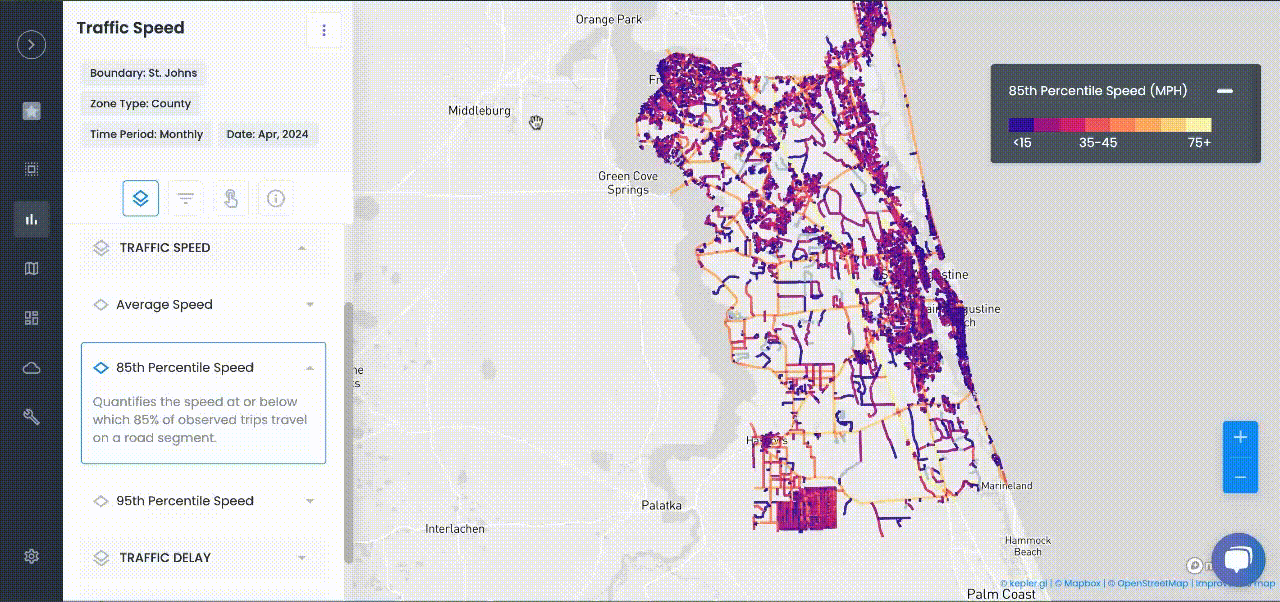
Road Safety
Top 5 Emerging Technologies Improving Road Safety in Smart Cities
Exploring five emerging technologies that are redefining how cities approach road safety.
Exploring five emerging technologies that are redefining how cities approach road safety.
As cities grow and traffic volumes rise, ensuring road safety has become one of the most urgent challenges facing transportation officials and city planners. Congestion, infrastructure aging, and shifting mobility patterns are all placing increasing pressure on public agencies to rethink how they approach safety — and fast.
Historically, traffic safety has relied on static signage, delayed crash reports, and resource-intensive enforcement. But those strategies alone can no longer keep up with the dynamic, data-rich environments cities operate in today.
To meaningfully reduce injuries and fatalities, public leaders are now adopting smarter, faster solutions. At Urban SDK, we're proud to support this shift by equipping agencies with real-time analytics, performance dashboards, and simulation tools that help turn proactive decision-making into safer streets.
Below, we explore five emerging technologies that are redefining how cities approach road safety — and why they matter more than ever for today’s public sector decision-makers.

The Urgent Need for Road Safety in Urban America
More than 40,000 people die in traffic incidents each year in the United States, with urban areas seeing rising numbers of pedestrian and cyclist fatalities. Local governments are under increasing pressure to:
- Meet Vision Zero goals
- Demonstrate equity in infrastructure planning
- Secure and report on federal safety funding
- Proactively identify and mitigate risk
But doing this manually—or retroactively based on crash data that’s months old—is both inefficient and ineffective. The future of road safety requires real-time insights and connected systems that empower public agencies to take smarter, faster actions.
1. Real-Time Traffic Analytics and Risk Monitoring
The foundation of any modern road safety strategy is accurate, timely data—not just about crashes, but about risky behavior before a crash happens.
Our platform helps agencies collect and analyze live data from:
- GPS and mobile sources
- Roadside sensors and telematics
- Public infrastructure and third-party feeds
With this information, cities can:
- Track vehicle speeds and identify speeding hotspots
- Measure school zone compliance in real time
- Detect congestion and risky travel patterns as they emerge
- Evaluate performance before and after safety projects
This level of granularity allows cities to prioritize where to act, justify safety investments with confidence, and continuously monitor progress over time.
2. Connected Vehicle Ecosystems (V2X)
Connected Vehicle-to-Everything (V2X) technology allows vehicles to communicate with:
- Traffic signals
- Pedestrian infrastructure
- Other vehicles
- Cloud-based management systems
When paired with real-time analytics, this ecosystem gives agencies new visibility into how drivers respond to signals, how congestion forms, and how to improve incident response coordination.
V2X also supports public goals such as:
- Reducing red-light crashes
- Improving pedestrian safety at intersections
- Creating connected corridors that adapt dynamically to flow
We're helping agencies plan for these emerging systems by integrating V2X performance data into our dashboards—so decision-makers can prepare their infrastructure for a more connected future.
3. Smart Infrastructure and IoT Integration
Roads and intersections can now be equipped with IoT-enabled devices that extend beyond passive infrastructure. These include:
- Dynamic speed limit signs that adjust based on weather or congestion
- Pedestrian-sensing crosswalks that illuminate when someone approaches
- Smart signals that adapt to real-time demand
- Structural sensors that alert maintenance teams to safety issues
Integrating these technologies provides cities with automated feedback loops, enabling them to respond to changing conditions without relying solely on human intervention.
We work with public agencies to ensure that the data from smart infrastructure feeds directly into a centralized performance platform—giving city planners and public works departments a unified view of road safety operations.
4. AI-Enhanced Road Monitoring (Vision Systems)
Artificial intelligence, paired with traffic cameras, offers deeper insights into why risky behavior occurs—not just where it results in crashes.
AI-based video analytics can detect:
- Red-light violations
- Wrong-way driving
- Sudden stops and near misses
- Unsafe pedestrian interactions
- Dangerous lane changes
We help cities translate these visual signals into data-driven strategies—whether that means adjusting signal timing, redesigning an intersection, or applying for funding to support enforcement tools.
With AI-driven monitoring, road safety becomes predictive, not reactive.
5. Digital Twins for Roadway Simulation and Planning
Digital twins are live virtual models of a city’s transportation system. They allow planners to simulate and visualize how different infrastructure or policy changes could impact safety outcomes—before anything is built.
By creating a digital twin powered by live data, agencies can:
- Forecast crash risk based on current travel behavior
- Simulate emergency response times during construction or events
- Evaluate the impact of road diets, bike lanes, or signal changes
- Justify infrastructure changes in grant applications with projected ROI
We support cities in building and maintaining digital twins, giving them a low-risk way to explore high-impact decisions—and a compelling story to share with constituents and funding agencies.
Case Studies: Cities Leading the Way
Across the U.S., city and state agencies are already seeing measurable safety improvements by leveraging real-time data, smart infrastructure, and performance analytics. Here’s how a few cities are using Urban SDK to take a more proactive approach to traffic safety:
- In McAllen, Texas, real-time speed data helped the city identify unsafe school zones and secure funding for targeted traffic calming improvements as part of their Vision Zero initiative.
- Fort Pierce, Florida used live traffic analytics to retime signals, streamline corridor planning, and strengthen infrastructure grant applications — all while improving transparency with the public.
- Chesapeake, Virginia tackled a growing backlog of citizen speeding complaints by validating risk areas with data and prioritizing interventions based on real-time performance insights.
These cities — and many others — are transforming how they manage mobility by making decisions based on real-time risk instead of reactive reporting.
Explore more success stories in our case studies
Conclusion: A Smarter Road to Safety
Improving road safety in today’s cities demands more than policies and pavement — it requires timely insights, connected infrastructure, and data you can act on. With the right technologies in place, public leaders no longer have to wait for crash reports to tell them where the problems are. You can see risk in real time, respond faster, and measure outcomes with clarity.
At Urban SDK, we're working with transportation agencies to:
- Transition from reactive to predictive safety strategies
- Use real-time analytics to guide decisions and track progress
- Leverage digital twins to simulate improvements before building
- Align with national programs like Vision Zero and SS4A — with measurable impact
These technologies aren’t just upgrades — they’re enablers of safer, smarter, and more equitable communities. And we’re here to help make that vision a reality, one corridor at a time.

TRAFFIC ENFORCEMENT FEATURES
80% of citizen complaints
are a perception problem
Urban SDK provides precise hourly speed data to evaluate complaints and deploy resources efficiently for the greatest impact to public safety.
Urban SDK provides precise hourly speed data to evaluate complaints and deploy resources efficiently for the greatest impact to public safety.
Target Speeding
Identify hot spots, validate monthly speeding trends and monitor vulnerable areas like school zones.
Improve Safety
Crash and citations location information to compare speed trends month over month
Fast Response
Respond to citizen complaints sooner with address search and exportable reporting
Deploy Assets
Generate maps for traffic enforcement by time of day, location or division to deploy officers to known problem areas.
RESOURCES
Customer Success
See how public sector leaders succeed with Urban SDK.
WEBINAR
Identify speeding and proactively enforce issues
See just how quick and easy it is to identify speeding, address complaints, and deploy officers.







